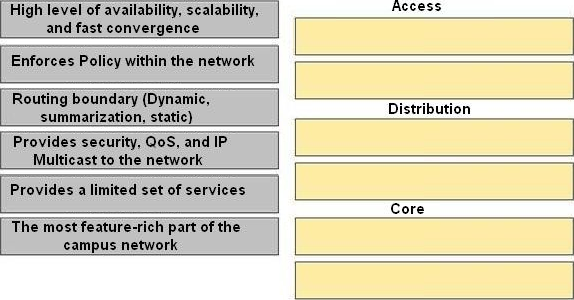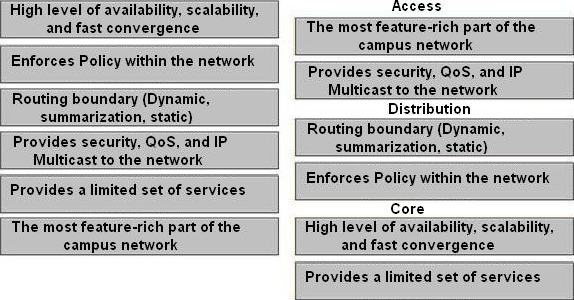DRAG DROP
Drag the characteristics of the traditional campus network on the left to the most appropriate hierarchical network layer on the right.

Answer: 
Explanation:
Large-Building LANs
Large-building LANs are segmented by floors or departments. The building-access component serves one or more departments or floors. The building-distribution component serves one or more building-access components. Campus and building backbone devices connect the data center, building-distribution components, and the enterprise edge-distribution component. The access layer typically uses Layer 2 switches to contain costs, with more expensive Layer 3 switches in the distribution layer to provide policy enforcement. Current best practice is to also deploy multilayer switches in the campus and building backbone.
Cisco Enterprise Architecture Model
Core
– Fast transport
– High reliability
– Redundancy
– Fault tolerance
– Low latency and good manageability
– Avoidance of slow packet manipulation caused by filters or other processes
– Limited and consistent diameter
– Quality of service (QoS)
Distribution
– Policy-based connectivity
– Redundancy and load balancing
– Aggregation of LAN wiring closets
– Aggregation of WAN connections
– QoS
– Security filtering
– Address or area aggregation or summarization
– Departmental or workgroup access
– Broadcast or multicast domain definition
– Routing between virtual LANs (VLAN)
– Media translations (for example, between Ethernet and Token Ring)
– Redistribution between routing domains (for example, between two different routing protocols)
– Demarcation between static and dynamic routing protocols
Access
– Layer 2 switching
– High availability
– Port security
– Broadcast suppression
– QoS
– Rate limiting
– Address Resolution Protocol (ARP) inspection
– Virtual access control lists (VACL)
– Spanning tree
– Trust classification
Power over Ethernet (PoE) and auxiliary VLANs for VoIP
Cisco Press CCDA 640-864 Official Certification Guide Fourth Edition, Chapter 3

Leave a Reply